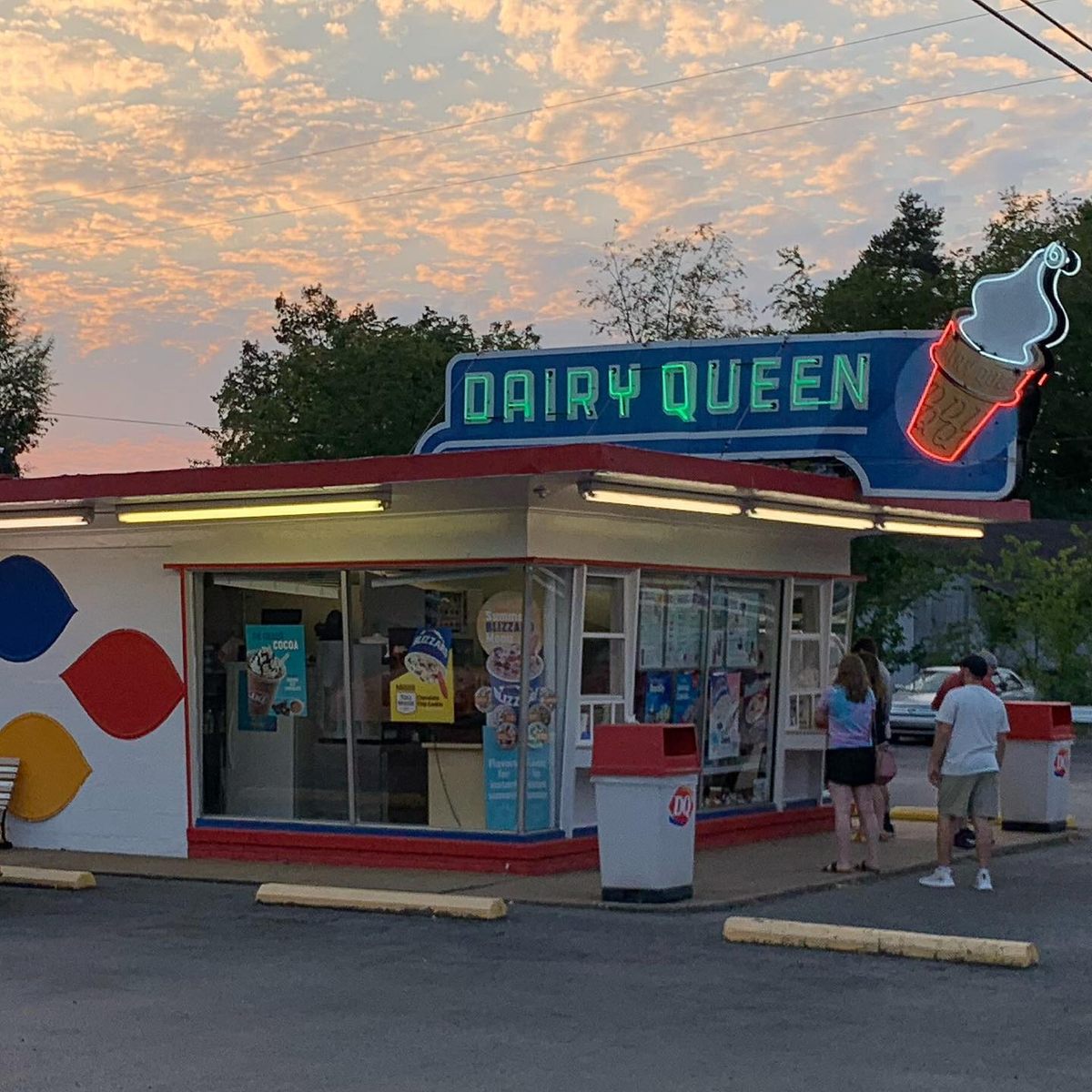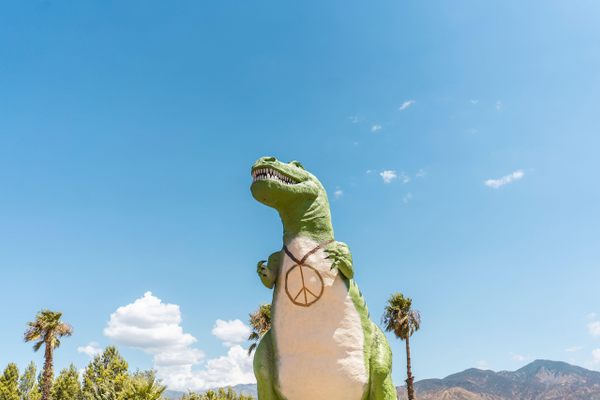The Retro Lover’s Guide to Road-Tripping
Inside one man’s quest to visit the last vestiges of roadside Americana.
One Saturday morning in 2022, Rolando Pujol awoke in his Queens apartment with a hankering for orange juice. So he got in his car, drove nearly 400 miles, and pulled into a Montreal parking lot that sat in the shadow of a three-story-high giant orange.
This wasn’t just any juice stand. It was Gibeau Orange Julep, a towering dome run by a family that’s slung their orange juleps—a creamier take on squeezed citrus, thanks to the addition of powdered egg—since the 1930s.
“Most people spend, like, a year planning that,” he laughs. “I just go.”
This is a typical weekend for Pujol, who spends his free time traveling the country and chronicling the history of roadside Americana (“well, Canadiana” in the case of the giant orange, he points out) for his online alter-ego, The Retrologist. Armed with a camera and a penchant for combing through old newspaper archives, Pujol explores stories ranging from endangered vintage Arby’s signs to the lone survivor of a long-forgotten fried-chicken chain.
Gastro Obscura spoke with Pujol about how to plan a road trip, his favorite routes, and the incredible history hiding in plain sight along highways and small-town main streets.

When did your obsession with retro roadside gems start?
I’ve loved this stuff since I was a kid. There is a phenomenon known as the smiling bear sign. I loved these signs when I was a kid because there was one near me where I grew up. I grew up in a Spanish-speaking household, so I would always say, “¡El oso! ¡El oso!” when we drove by it. Then one day the bear was gone.
Where I grew up, there was also a Holiday Inn with a very big green sign. And there was a mass extinction of those that was ordered by Holiday Inn in the early ’80s when they wanted to go for a new look. They were seen as kitschy throwbacks of the ’50s and ’60s. I still remember how one day the sign near me wasn’t there anymore, and it was replaced with this inferior smaller one. I was like, “That’s awful. Why would you do that?” And we continue to have all of these losses, coast to coast. So if you’re not getting to them, you’re going to miss them.

I love all your fast-food finds. Can you talk a bit more about your interest in that side of road-trip culture?
To me, so much of the story of America over the past 50 or 60 years is told in not only the food that these places serve but also in how these places are marketed, and how their signage and their buildings are designed. Just look at, to take one of my favorite subjects, McDonald’s, and how their architecture evolved from gaudy, neon, massive arches on a slanted glass building.
By the late ’60s, this is becoming a bit tacky, and McDonald’s needs to keep growing beyond the roadside. They want to get into downtowns and suburbs, so then they come up with the mansard building, which can fit into a New England downtown.
Then, a generation later, that look is becoming a bit dowdy. And now, of course, we seem to not want to market our stores using architecture or signage. They’re all gray boxes that are sterile and sleek and perhaps elegant in a Bahausian way, but they are not particularly interesting and not something that captures your attention.
I think many of my posts are about the evolution of fast-food architecture and how it’s gone from being whimsical and fun and quirky to becoming sterile, dull, and boring. I love keeping people updated on those great scandals of the American roadside, the McBoxings [when a McDonald’s loses its mansard roof and retro design, and adopts a more bland interior and box shape]. You might find a McDonald’s that has survived intact—there might be a Grimace in the background somewhere, and maybe there’s a PlayPlace—and then two weeks later, kaboom, it’s now a box store.
It’s something that people genuinely care about, but it’s also a rich subject matter.

Is there any road trip you’d recommend to someone interested in roadside Americana?
I’m a particular fan of following old routes that used to be transcontinental highways. A highway that doesn’t get as much attention as Route 66, but is just as interesting is the Lincoln Highway. You could start in Times Square because that’s where the Lincoln Highway used to begin. For many years there was actually a Lincoln Highway sign right there at 42nd and Broadway. You’d then continue and pick it up in New Jersey, then into Pennsylvania, where it’s Route 30.
You can take that clear across the state through Pennsylvania Dutch country on into Ohio. And along the way you’ll see things like this gorgeous art deco gas station in Bedford, Pennsylvania, which is the same town where you can find a big coffee pot.
And you could take the Lincoln Highway clear across the country. It ends in San Francisco. Parts of it align with other routes. For example, Highway 50 in Nevada, which is known as the Loneliest Highway. And if you visit certain places along the Loneliest Highway and get proof of it in a little stamp book, you send that book back to the tourism board and they’ll send you a certificate saying that you have completed it. I love that. It has pride of place on my refrigerator.

How do you pick and plot out all the places you’d like to visit?
I think you can find interesting examples of roadside Americana pretty much wherever you are, even in your own hometown. I use Google Maps to plan, and I have one for every state. And then I also have maps for categories like “Old Carvels” or “Old Dairy Queens.” And countries. So if I find something interesting in Spain, and I don’t know when I’m going to be in Barcelona, but I know there is a very interesting old pastry shop or whatever, I’ll add it. So it’s something that I’m constantly thinking about. The research never ends.
That’s interesting that you mention Spain because we often think of retro signage like this as a distinctly American phenomenon. What have your international finds been like?
I’ve taken two trips to Cuba over the years, which have been very meaningful to me because my parents are from Cuba. So much of the relics there are essentially American relics because of the hefty presence of American culture in Cuba, pre-1959. I remember when I visited in 2009, there was a sign that was carved into a building somewhere in old Havana for RCA Victor, unlike anything I’d ever seen before. But it was gone by the time I went back in 2019.

In your posts, you mention that you don’t always go inside some of the places you visit. What makes you choose to go inside and actually eat at some of the restaurants?
Whenever possible, I try to go inside. In fact, my greatest regrets are usually tied to not having gone in. Oftentimes it’s because you’re in a rush or because you’re getting maybe a bad vibe. Normally when I do go in, I try to disarm people. I’m like, “Hey, my name is Rolando, and I love your store. This is such a beautiful place.” Starting like that—with a show of reverence and respect for what they’re doing and an admiration for the work that they’re doing to keep this going—disarms people. Because most of these places are operating on fumes of love.
And sometimes the most interesting aspects are indoors—how the dining room is intact or the counter is extraordinary. There’s still a bank of pay phones. Or those old Taco Bell crazy ’90s interiors. Those were once standard and now they’re quite rare, so I love to go into those. If I see one that might have that, I’m, like, “Pull over.”

As someone who’s often out on the open road, do you have any advice or tips for road trippers?
Oh, boy. Obviously, I think research is very important. But you also need to bring an attitude of flexibility because you may not be able to stick to the plan. Just sort of relaxing and leaning into the process and trying to have fun. And to the extent that you can, make sure to see things that even seem difficult or out of the way because you may not ever be there again.
Talk to people, get to know them. That’s the main beauty of this. It’s making friends and bridging divides that exist between people.
This interview has been edited and condensed.
Gastro Obscura covers the world’s most wondrous food and drink.
Sign up for our email, delivered twice a week.


























Follow us on Twitter to get the latest on the world's hidden wonders.
Like us on Facebook to get the latest on the world's hidden wonders.
Follow us on Twitter Like us on Facebook